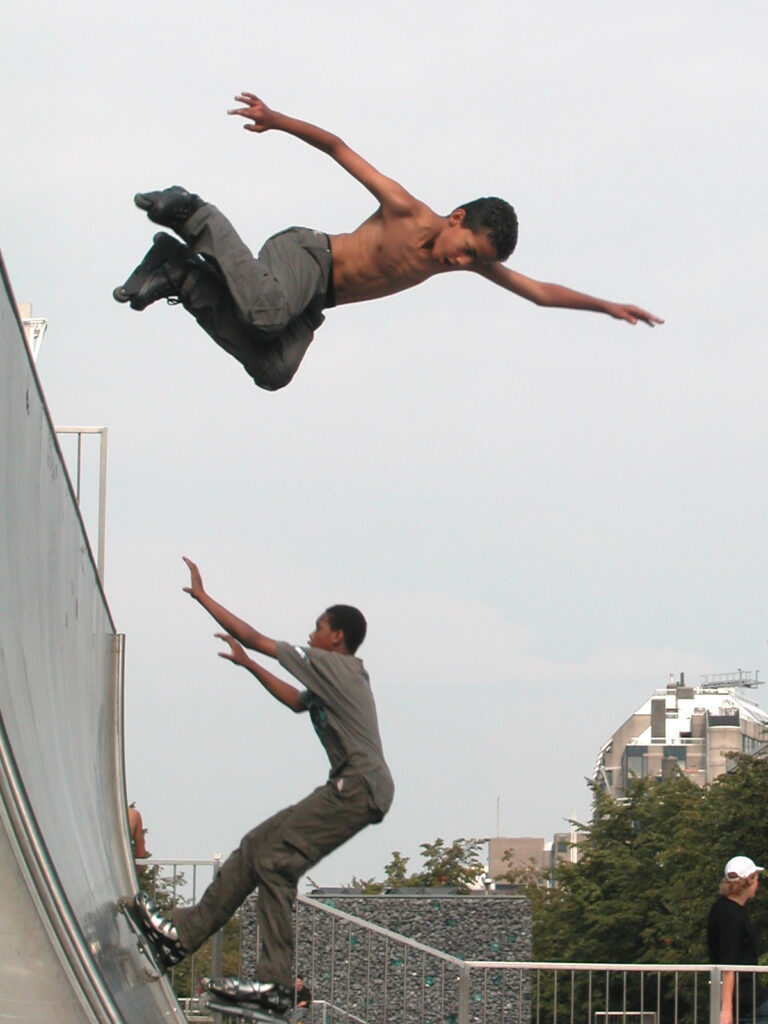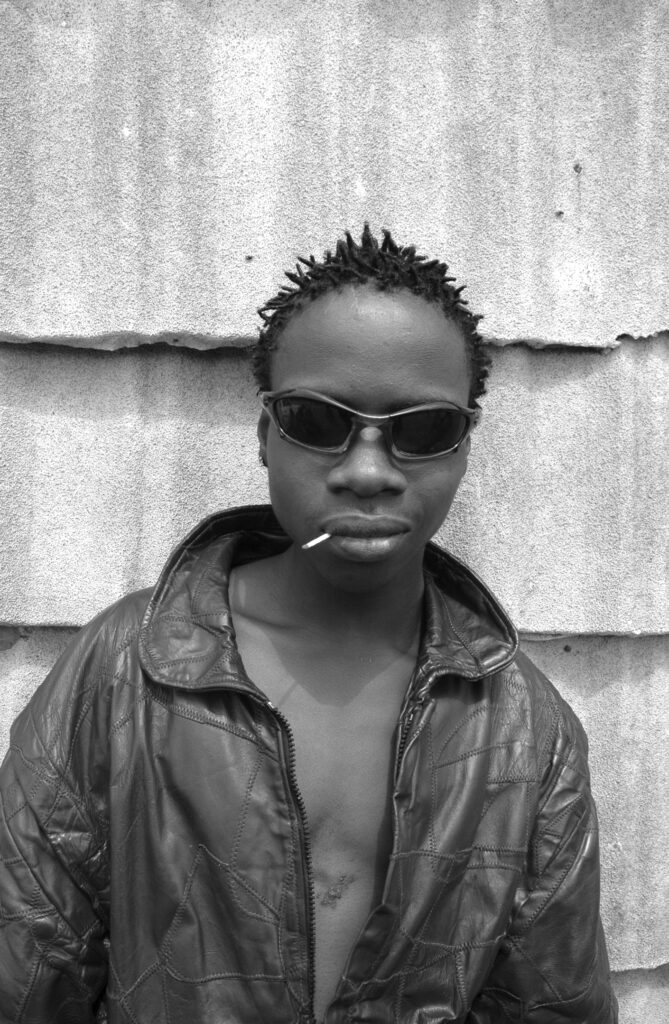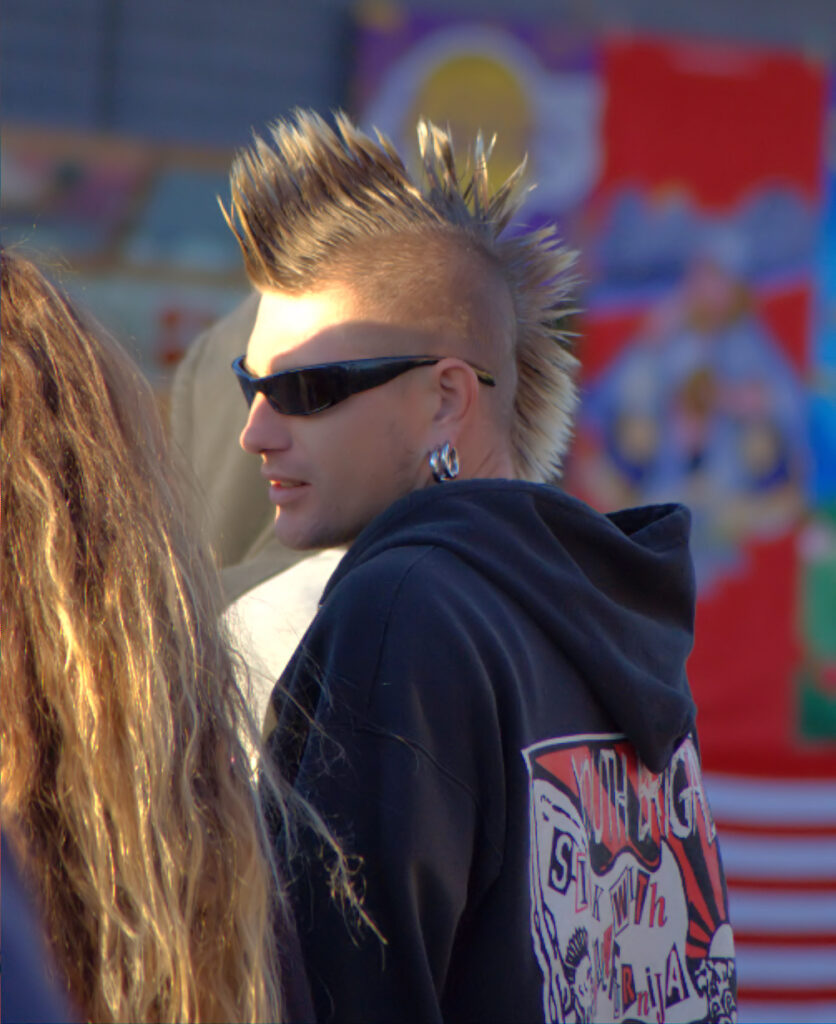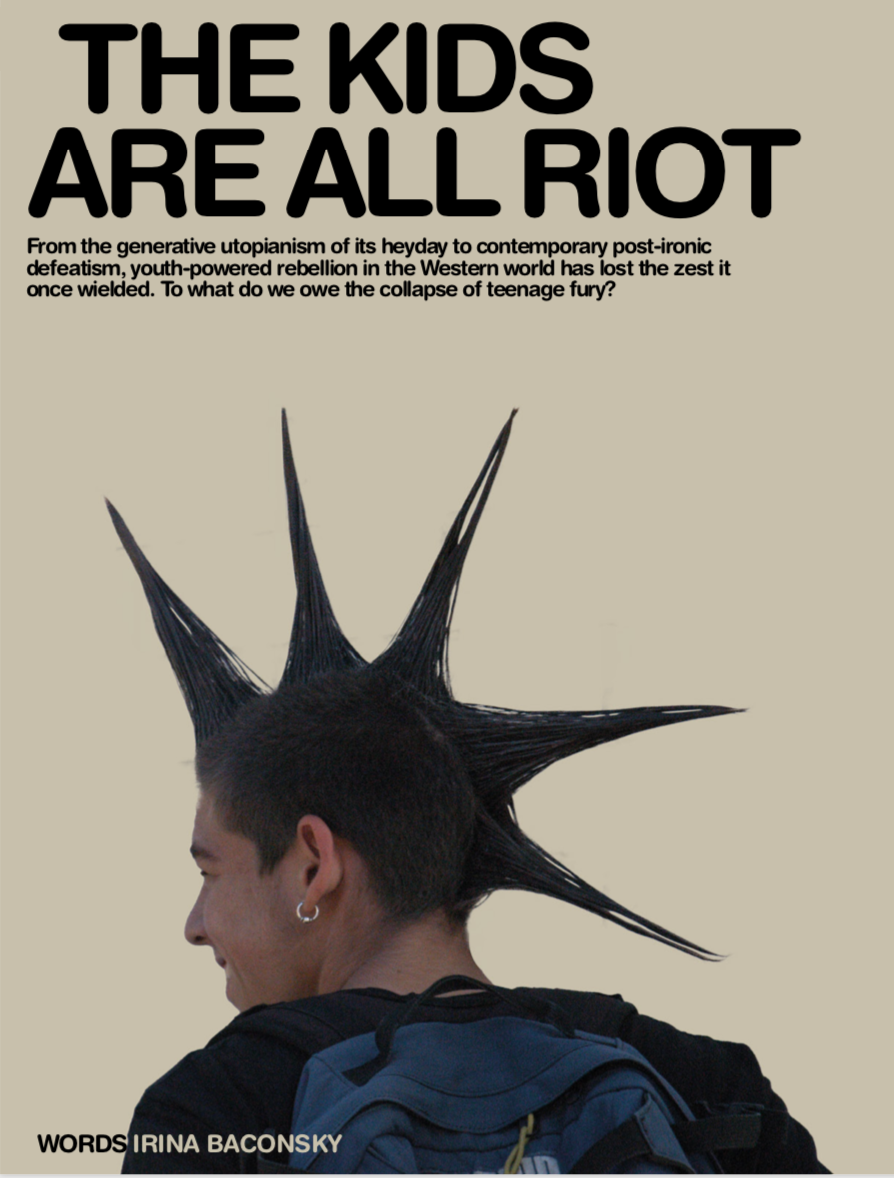From the generative utopianism of its heyday to contemporary post-ironic defeatism, youth-powered rebellion in the Western world has lost the zest it once wielded. To what do we owe the collapse of teenage fury?
Once upon a time, rebellion was hot. It was pop. Most importantly, across the hegemonic Western world, it was an inextricable part of the teenage vernacular. Somewhere along the way, a glitch has occurred—the contemporary notion of teenage rebellion in the West has been so atrophied under neoliberal capitalism, it’s become nearly impossible to discern. To what do we owe its defeat? And most importantly, how can we retrieve its ardour?
Teenagers were the wardens of insurrection—embodying the spirit of irresponsibility, idealism, and utopianism—seeing the world for what it could be, and not what they’d been told it should–or would–be. Proud artisans of recklessness, they didn’t aspire to work or get rich—what they yearned for was meaning, change, purpose, community. Most of all, they daydreamed of tearing up the rulebook and feeding its shreds to the fires of reinvention and individuality. Teenagers were as materially disempowered as they were culturally scary, tenacious, and threatening, because they didn’t care about fitting in. The very act of being a teenager meant doing everything in your power not to [fit in]—even when doing so was only meant to piss off your parents, or to blend in with your friends (teenagers certainly never escaped the trap of mimesis). There was something about the thrill of dissenting to a ruling system that made rebellion desirable. Teens fashioned their own glittery wastelands and found shelter within. For decades, the titanic potency of teenage delusion caused mass waves of cultural transmutation. In the 1960s, under the recently discovered influence of entheogens and hippie formulas for social cohesion, young people massively contributed to making the Vietnam war one of the most unpopular in US history. They fought back and disobeyed when lectured on the inevitability of a linear future, and for a long time, regardless of the form it took, that spirit of dissidence fashioned a notion of cool, spreading it across youth culture like wildfire.

Far beyond the ‘60s, the sonic and aesthetic backdrop to most youth cultural movements (not always spearheaded by teenagers, of course) both mirrored and bolstered this collectively galvanising effect. Punk, grunge, hip hop (which for years was considered a public danger, struck by every type of censorship and demonisation under the sun), hardcore, reggae, metal: all harnessed a sense of anger, rage, and raw energy, drumming the collective unconscious into an unapologetic—if imperfect—spirit of relentless insurgence. A youth movement such as Detroit techno, birthed by the likes of Drexciya, Underground Resistance, or The Belleville Three (who started out while in high school) was all about using progressive soundscapes and immersive sonic experiences to envision Afrofuturist utopias as political alternatives to America’s racial oppression. Pop music itself, through figures such as Madonna-–herself a teenager when she entered the music industry-–was often bold, polarising, and met with censorship.
Post-9/11, a disheartening shift overtook the western cultural mood. What once carried an impetus of rebellion has since been watered down (if not quashed) into sadness, ennui, defeatism, and, consequently, into subliminal encouragement to compliance and homogeneity. Today’s youth culture appears to take the form of a fast-fashion-clad teenage mainstream, gripped with an existential fear of alienation from the pack of woke conformity. Once echoing ideals rather than the narrow brackets of permissibility, identity politics themselves have become co-opted by their shared tyrant—Western neoliberalism—and yassified into suffocating templates of inescapable and utterly unthreatening forms of institutionally-ordained legitimacy.
Aesthetic rebellion, in the sense of alternative-thirsty insurgence, is no more. Today’s dissidence translates into sharp, post-ironic shades of nihilism. Even still, they require celebrity endorsement or heritage Maison-approval (from the likes of Louis Vuitton, Dior Homme or Balenciaga) to seep into mainstream contemporary ideals of cool. The uncomfortable reality is that, at this point, true dissidence (whether you agree with it or not) has become dangerously cast off as variably conspiracy theory, mental illness, or political incorrectness.

What does rebellion look like today? Pockets of individual resistance still exist, at least temporarily, but are quickly discarded, until the powers that be have figured out a way of folding their more harmless elements into dominant pop culture. Before trend forecaster K-hole coined the term “normcore”, before Vetements and its heritage twin Balenciaga popularised the aesthetic of self-derision amongst Western youth, the politically provocative sartorial conformity of Shia LaBoeuf (and the performance art and public persona that came with it) was quick to be dismissed as the lunatic antics of a burnt-out, mentally unstable fading Hollywood star. If women in the public eye who dared to fight back in any capacity—Britney Spears, Courtney Love, Azealia Banks, to name a few—have long been branded as mentally ill, the phenomenon has more recently also started to affect men, LaBoeuf being a prime example, Kanye West another. Yes, these men are both deeply flawed, and certainly have shown signs of instability. These insinuations of mental illness may or may not be accurate, but nor are they relevant. What is truly concerning is the conflation of their mental states with their social critiques, implying that it is mental illness to hold views so radically dissident (and threatening) to a system in power. Whether West is bipolar or not should have no bearing on the legitimacy, or relevance, of his words and actions, particularly when it comes to his artistic statements. Past icons of the disaffected youth such as Friedrich Nietzsche, Kurt Cobain, Hunter S Thompson, or Arthur Rimbaud are all reported to have suffered from grave, even debilitating forms of mental illness and/or severe forms of addiction, yet these haven’t undermined their artistic and mass cultural credibility.
In 2022, Gen Z icon Selena Gomez publicly disclosed having been diagnosed with bipolar disorder after a stay in rehab and several admitted psychotic episodes. That didn’t cost her her 427 million Instagram followers (the third most followed account in the world). In spite of the aggressive pathologisation and demonisation women in the public eye tend to incur following discussions of their mental health—most notably fellow former Disney Channel star Britney Spears—, no one muzzled Gomez, nor was she locked up; no one took away her rights, nor was her every word discredited—because she behaves. She complies. She doesn’t ruffle feathers. So, bipolar or not, she was allowed to remain an idol to teenagers everywhere, a Hillary Clinton-backed figurehead of good girl energy. Just try picturing her making more of a statement, breaking the mould, dyeing her hair red—or shaving it, denouncing Obama’s mass deportations of Latin Americans, or the war in Syria. Picture her singing lyrics in the vein of M.I.A.’s 2005 MTV-banned ‘Sunshowers’: ‘You wanna win a war? / Like PLO [Palestine Liberation Organisation] I don’t surrendo!’ You can’t? Yep, neither can I. Even assuming those were her politics, as an ‘out’ bipolar person, she knows she can’t afford to go that far, and discussing her friendship with Taylor Swift (another paragon of Bible Belt pop) is about as far as she’s culturally allowed to venture in order to retain her queendom.

The rebels of yesteryear rocketed to pop stardom (and/or notoriety) based on the spirit and impetus behind their ideals, not their personal lives, the state of their mental health or even their personal politics, which were most likely flawed, just as all of ours are or have been, at some point. Regardless, they certainly did not catapult to cultural relevance based on their docility. Youth cultural movements of the past didn’t reach international heights because of their compliance, tacit or outspoken, to the status quo. Teens used to source power in the threat they posed to the status quo, a seismic political force their enemy learned to acknowledge, and even reckon with. Late capitalism has, in recent years, savvily outmanoeuvred countercultures by “buying out” would-be rebel youths with the fiction of a woke, ethical form of corporate existence; one where they can simultaneously ‘make money’, dissociate from the meaningful concerns of the working class or foreign policy problematics, and retain their social media bio pronouns, intricate nail art, overpriced sneaker collections and contouring sets.
Nixon’s ‘War on Drugs’ really was a war on mass teenage rejection of stifling, puritanical values. In France, the May ‘68 riots were a middle class, white-youth-powered social revolution—yes, it had bourgeois inflections, a mutiny of the privileged and educated. But what is today’s educated, bourgeois youth getting up to? Are they rallying by the millions to protest censorship and surveillance? Nepotism? War? Who is using their academic privilege to spearhead a movement of cyber-anarchist emancipation from the grips of disciplinary, biopolitical fascism we call Anthropocenic? If such people do thankfully exist, they remain marginal, their teenage archetypes all but romanticised on youth-oriented shows, or in song lyrics.
Instead of explicitly starving the youth of self-expression and dignity, like in the (overtly) puritanical ‘60s, the (covertly) puritanical rule-makers of today have engineered the genius marketing trick of selling young people the illusion of choice, autonomy, and liberal authenticity by means of an endless proliferation of what late anthropologist and Occupy Wall Street figurehead David Graeber called “bullshit jobs”: pseudo-managerial, corporate, vapid jobs breadcrumbing the masses–not just into submission, but, more perniciously, intersectional bickering, finger-pointing and worst of all, a profound sense of communal defeatism. From SoundCloud rap, or ‘sad rap’, to Billie Eilish, (much needed) discussions of depression rarely come with a side of hope, slim as it may be. Today’s supposed collective empowerment through art and fashion is, in fact, supremely disempowering, yet well-packaged enough to fool our discernment and trauma-exhausted young brains from daring to ask for more, to look for alternatives. “We’re here, we’re queer, we’re coming for your children” chants got traded for ‘gay and tired’ merch.
But that exhaustion is not ours—it belongs to a collapsing, ageing system of power, doing everything it can to conceal its imminent implosion by transmuting its impotence into sedative social engineering. And we’re falling for it. In late 2020, subcultures such as ‘lobotomy chic’, ‘ketamine chic’ and their accompanying vacant stare selfie trends were making waves online. Euphoria’s Chloe Cherry became an icon of the ‘dissociative pout’. According to a 2021 Centers for Disease Control and Prevention survey, nearly three in five US teenage girls have said they feel “persistently sad or hopeless.” Giving up at 16 has never looked so glamorous.

Over a more engaged yet equally bland timeline of contemporary youth rebellion towers the Western world’s foremost teenage rebel, Greta Thunberg—an articulate, Scandinavian, virginal, blonde, and righteously disobedient young woman fighting a fight so unconscionably urgent it’s being discussed at the UN, and supported, though mostly symbolically, by Democratic America. Greta does pay generic lip service to critiques of capitalism and the environmental cataclysm engendered by colonialism. Yet her speech, demeanour and aesthetic still play by the rules enough to be extolled by heads of government.
Trendy as it may be, the nihilism prevailing across the dominant cultural discourse is a luxury of the white, the Western, the middle class (and more often than not, the male). Across the vast majority of the world—egregiously lumped together as the “Global South”—artists and the youth have never ceased to harness hope, their work ideal-laden. Celebrating potential, power, and joy–rather than defeat–is visible in movements ranging from Gulf Futurism in the Middle East, Afrofuturist aesthetics melding African folklore and tradition with empowering uses of technology, or musical genres such as Brazil’s wildly popular, favela-born Baile Funk beats. Joy, hope, and celebration still abound in places where oppression and injustice are not concealed behind the tokenistic veneer of Black-square radicalism.
The cure to the urgency of our disciplinary capitalist dystopia is not necessarily to flood the streets in protest, or even mosh like in the days of Twiggy and early Marilyn Manson. If such were the tactics of the pre-internet era, the rebels of today have the undeniable advantage of technology. During the Thai student protests of 2020-21, the internet became a space of possibility and defiance to censorship, a space for storytelling as well as community-building. The ‘Bad Student’ movement gained popularity among high school students by means of anonymous Twitter and YouTube accounts with several hundred thousand followers, powering the collective narrative of the dissatisfied, rebellious student resolved to disobey authority and reject docility. Today, rebellion has the potential to be more slippery—and thus more powerful—than ever before. Young Thai artists, such as Harit Srikhao, or Nawin Nuthong use fantasy and technology as vectors to deconstruct propagandist mythologies and reconfigure understandings of Thai history.
While youth-led mass movements of the past are not to be idealised, nor their shortcomings glazed over, the ethos of rebellion as a hunger for alternative, the spirit of dissidence and acerbic questioning in the face of hegemonic socio-political narratives are begging for a renaissance. Our aesthetic reservoirs, our sonic and artistic imagination, are calling for more life-affirming iterations of cool. Not a replica, but an alchemisation of the fire and hope that once fueled collective dreams and imaginings of alternative possibilities. Tireless, devotional faith in such alternative worlds, in the promise of joy, and in life itself is a radical act of defiance we owe the skeletons of our exhausted rage.



